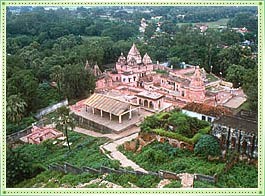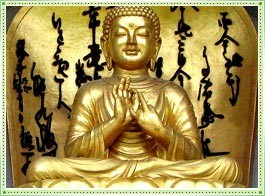
Rajgir was the place where Lord Buddha spent twelve long years in meditation.
Rajgir is equally important and relevant for Buddhists, Jainas and Hindus. Mahavira had spent some time at this spot before getting Kevalya. Mahavira, the
Rajgir was the venue for first Buddhist Council. The council was held at Saptparni caves. There was a famous monastery at Jivkamaravana and Lord Buddha often visited this monastery out of love and affection. The development and popularity of Buddhism among
Rajgir has many tourist attractions including of Griddhakuta hill, the place which saw the conversion of Magadha king Bimbisara to Buddhism. Other places such as the Jail of Bimbisara, Gym of Jarasandha, Venuvana, Karand tank, Maniyar math, Swamabhandar cave, Pippala cave, newly constructed Viswa Shanti Stupa are some major tourist attractions at Rajgir. Rajgir houses some
Rajgir is part of Buddhist Tourist Circuit and is linked with other Buddhist pilgrim destinations which are relevant for Buddhists across the globe. Rajgir is just ten kilometres away from Nalanda, another Buddhist pilgrim destination of great relevance. King Bimbisar donated a monastery to Lord Buddha for his residence at Rajgir called Venuvana Vihar. Remnants of that construction can be seen even today.

How to reach Rajgir
Rajgir, the place where Lord Buddha spent a significant part of his life, is a
popular pilgrim destination for Buddhists across the world. The place also
served as the meditation center for Lord Mahavir Jain, the twenty fourth
tirthankar of Jain religion. Being the center for the growth and development of
two popular religions Rajgir attracts a large number of visitors. Rajgir is a
part of Buddhist Circuit and for that reason is well connected with other
destinations.
By
Rail
Rajgir railway station is linked with other cities by a whole range of trains.
The place is well linked with Gaya and from Gaya you can board trains for
Mumbai, Delhi, Chennai, Kolkata, and Bangalore. After getting down at Gaya, which
is just 34 kilometers away, you can hire taxis for Rajgir.
By
Air
Gaya is the nearest airport from Rajgir. There are frequent flights from Gaya
to other metro cities of India. You can get down at Gaya and from there board
buses or taxis for Rajgir. Other than Gaya, Patna airport is another good
option. Patna is well connected with other metro cities of India and some major
cities of world.
By
Road
Rajgir is linked with most of the cities of Bihar by road network. There are
regular bus services from Patna, Nalanda to Rajgir. Other than buses run by
State Tourism Department, some private tourist operators too have bus services
of their own. You can hire taxis from these places for better and comfortable
journey to Rajgir.Rajgir Weather:
Summer: Max: 44.5 ºC; Min: 20.5 ºC
Winter: Max 28 ºC; Min: 5 ºC
Rainfall: 214 cm annually
Best season: Oct-Feb
Clothing: Cotton clothes during
summer and woolen during winters.
Rajgir the ancient capital of Magadha kings was once the epicenter of religious
and political activities. Later on king Ajatshatru chose Pataliputra over
Rajgir for Pataliputra was strategically located. Lord Buddha, the founder of
Buddhism, spent a significant time here at Rajgir. He stayed and meditated and
delivered many sermons to his disciples. Similarly Mahaivr Jain of Jain sect
stayed and meditated at Rajgir.
Summer
As Rajgir is situated in tropical region the weather condition is typical of
any tropical city. Summers are hot and humid. Temperature reaches at 45 degree
Celsius. Wile traveling to Rajgir in summer, you must carry light cotton
clothes.
Winter
Winter is the best season to visit Rajgir. Days are pleasing and nights a bit
cold during winter season. You must carry warm woolen clothes while exploring
Rajgir in winter.
Monsoon
Rajgir receives a lot of rain during Monsoon months. Rains bring freshness and
the small hillocks become more picturesque and attractive during monsoon.
Rajgir Tourist Attractions
The ancient capital of Magadha, Rajgir is an important Buddhist and Jain
pilgrim destination. Rajgir was the hotpot of political and religious
activities in ancient India, still has relevance in modern times. Both, Lord
Buddha and Mahavir Jain spent a significant portion of their lives at Rajgir.
King Bimbisar even donated a monastery to Lord Buddha.
Rajgir has number of tourist destinations to see. Many of them are relevant and
important for Buddhists and Jain followers and some are important for Hindus
too. Gymnasium of Jarasandh and Bimbisar, Saptparni caves, Gridhkut hills, and
Jivakameavan Gardens are major tourist attractions at Rajgir.
Gymnasium of Jarasandh
Jarasandh, a mythological fighter of Mahabharat, is said to have his gym at
Rajgir. Legend tells us that Bhim had defeated Jarasandh in one of their duels.
Though historically it can not be proved, local belief of the fact has to be
accepted.
Ajatshatru Fort
Ajatshatru, who ruled Magadha, built a fort here. Other than that fort, there
is one Stupa which is believed to have been built by Ajatshatru is a major
attraction at Rajgir.
Shanti Stupa
Named for the mission of establishing world peace, the Vishwa Shanti Stupa is
located at an altitude of 400 meter. Built in marble, the stupa is adorned by
four statues of Lord Buddha from four side-corners. You can reach to the spot
by ropeway.
Cyclopean Wall
The Cyclopean wall was meant for the fortification of the capital city of
Rajgir. Earlier it was 40 Km long and encircled ancient Rajgir. The
construction of the wall is of stones. This Pre-Maurayan structure is a major
tourist attraction among tourists. Though not in existence in its glorious
form, its traces are still there and boast the grandeur of its existence at
some point of time.
Sonbhandar Caves
There are numerous folklores of mysteries associated with these caves. There
are two halls inside the cave and as believed one of them served as guard room
and another as treasure room. Local people are of opinion that some treasure
from Bimbisar is still safe inside the cave. People try to get some clue from a
non-deciphered inscription. Besides the treasure theory of Sonbhandar caves,
the spot has great attraction for its historical links with Bimbisar of
Magadha.
Venu Vana
Lord Buddha had become popular during his life time and had earned a good many
disciples among whom some were rulers. One of such rulers was king Bimbisar of
Magadha. Bimbisar, out of respect, donated a monastery to Lord Buddha which is
called Venuvana Vihar.
Bimbisar Jail
Bimbisar, a staunch follower of Lord Buddha, suffered a lot from his own son,
Ajatsatru. Ajatshatru imprisoned his father Bimbisar and asked him to choose
the place of imprisonment. King Bimbisar chose this spot as from here he could
see Lord Buddha everyday.
Jain Temples
Rajgir is as important for Jain followers as the Buddhists. In and around the
Rajgir hill, there are 26 temples which can be reached by trekking on the
mountain. Here comes the real test of your stamina to climb the peaks.
Chariot Route Marks
The mysterious rock cut in the form of two parallel furrows deep into rock for
about thirty feet are worth visiting. According to local beliefs, the cut is
the path of Lord Krishna’s chariot. When Lord Krishna visited Rajgir owing to
the power and force and speed of his chariot the root became like this. Another
attraction at the place is a non deciphered script dating from the 1st to 5th
century AD, engraved in the rock around the chariot marks.
Pippala cave
There are hot springs and above the hill is the cave Pippala in Vaibhava Hill.
These caves are not man made but natural. These were, according to some
historians, were used as watch towers and later housed monks.